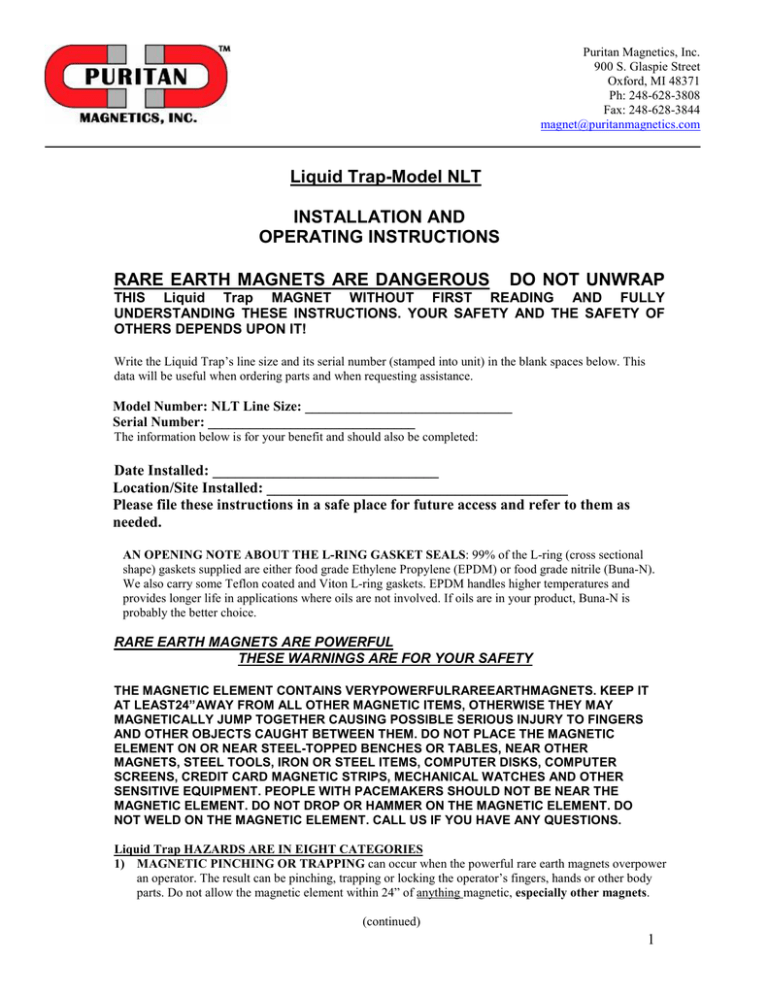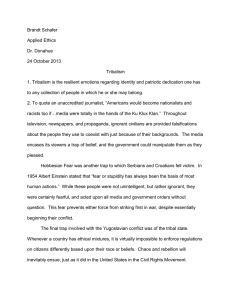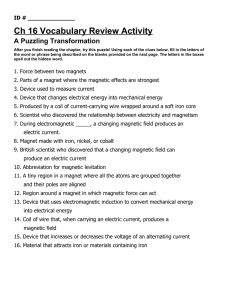Liquid Trap-Model NLT INSTALLATION AND OPERATING
advertisement

Puritan Magnetics, Inc. 900 S. Glaspie Street Oxford, MI 48371 Ph: 248-628-3808 Fax: 248-628-3844 magnet@puritanmagnetics.com Liquid Trap-Model NLT INSTALLATION AND OPERATING INSTRUCTIONS RARE EARTH MAGNETS ARE DANGEROUS DO NOT UNWRAP THIS Liquid Trap MAGNET WITHOUT FIRST READING AND FULLY UNDERSTANDING THESE INSTRUCTIONS. YOUR SAFETY AND THE SAFETY OF OTHERS DEPENDS UPON IT! Write the Liquid Trap’s line size and its serial number (stamped into unit) in the blank spaces below. This data will be useful when ordering parts and when requesting assistance. Model Number: NLT Line Size: ______________________________ Serial Number: ______________________________ The information below is for your benefit and should also be completed: Date Installed: ______________________________ Location/Site Installed: ________________________________________ Please file these instructions in a safe place for future access and refer to them as needed. AN OPENING NOTE ABOUT THE L-RING GASKET SEALS: 99% of the L-ring (cross sectional shape) gaskets supplied are either food grade Ethylene Propylene (EPDM) or food grade nitrile (Buna-N). We also carry some Teflon coated and Viton L-ring gaskets. EPDM handles higher temperatures and provides longer life in applications where oils are not involved. If oils are in your product, Buna-N is probably the better choice. RARE EARTH MAGNETS ARE POWERFUL THESE WARNINGS ARE FOR YOUR SAFETY THE MAGNETIC ELEMENT CONTAINS VERYPOWERFULRAREEARTHMAGNETS. KEEP IT AT LEAST24”AWAY FROM ALL OTHER MAGNETIC ITEMS, OTHERWISE THEY MAY MAGNETICALLY JUMP TOGETHER CAUSING POSSIBLE SERIOUS INJURY TO FINGERS AND OTHER OBJECTS CAUGHT BETWEEN THEM. DO NOT PLACE THE MAGNETIC ELEMENT ON OR NEAR STEEL-TOPPED BENCHES OR TABLES, NEAR OTHER MAGNETS, STEEL TOOLS, IRON OR STEEL ITEMS, COMPUTER DISKS, COMPUTER SCREENS, CREDIT CARD MAGNETIC STRIPS, MECHANICAL WATCHES AND OTHER SENSITIVE EQUIPMENT. PEOPLE WITH PACEMAKERS SHOULD NOT BE NEAR THE MAGNETIC ELEMENT. DO NOT DROP OR HAMMER ON THE MAGNETIC ELEMENT. DO NOT WELD ON THE MAGNETIC ELEMENT. CALL US IF YOU HAVE ANY QUESTIONS. Liquid Trap HAZARDS ARE IN EIGHT CATEGORIES 1) MAGNETIC PINCHING OR TRAPPING can occur when the powerful rare earth magnets overpower an operator. The result can be pinching, trapping or locking the operator’s fingers, hands or other body parts. Do not allow the magnetic element within 24” of anything magnetic, especially other magnets. (continued) 1 Puritan Magnetics, Inc. 900 S. Glaspie Street Oxford, MI 48371 Ph: 248-628-3808 Fax: 248-628-3844 magnet@puritanmagnetics.com Liquid Trap-Model NLT – Installation and Operating Instructions (continued) 2) 3) 4) 5) 6) 7) 8) MAGNETIC DESTRUCTION whereby video screens can be destroyed, credit card magnetic strips and computer disks erased, mechanical watches magnetized (ruined), and other sensitive equipment (PACEMAKERS) made inoperable by being exposed to a powerful magnetic field. Do not allow the magnetic element close to any such sensitive equipment. LIQUID AND CHEMICAL BURN HAZARDS are present depending upon the processing temperature and the products being processed or being used for cleaning. Hot product can spill on an operator when the Liquid Trap Magnet is taken apart for cleaning. Chemical burns can occur if offending chemicals are present. Similarly, offensive fumes could overpower an operator. Such accidents can also occur if gaskets are not properly seated, defective gaskets are used, the band retaining clamp not properly seated, tightened and locked, or if the clamp is accidentally opened while processing. SLIPPING AND FALLING HAZARDS can be present if liquids are on the floor. Liquids can spill from the Liquid Trap Magnet when it is opened. Spilled liquids can make the floor slippery and cause people to fall. Anticipate this problem and prevent spills and drips from reaching the floor by using containers to catch the liquids. Personnel should wear non-skid footwear and non-skid mats should be properly located. TOTAL FLOW BLOCKAGE OR REDUCED FLOW due to trash build-up inside the Liquid Trap. Clean the Liquid Trap on a regular basis to prevent the accumulation of unwanted debris. GASKET FAILURE can cause product to leak from the system. Inspect the gaskets for cuts or abrasions that can cause leaks. Test gaskets by flexing them to see that they are flexible and have not hardened. Be sure the gaskets fit smoothly in place and are not wrinkled or distorted. CLAMP FAILURE can endanger personnel and damage equipment. Insure that Liquid Trap Magnet parts fit together smoothly. The clamps must be properly seated in both grooves. The clamp’s T-bolt must fully engage the pivoting yoke and it must be parallel with the body. The safety latch must engage the overthrow lever to assure that it is locked in the closed position. OVERPRESSURE IN THE LINE can create leaks at the gaskets. Extreme overpressures can break clamps and send the magnet or lid flying. When a Liquid Trap Magnet is installed after a pump, never pressurize the line with all downstream valves closed. TIPS FOR BEST Liquid Trap LOCATION AND SAFETY Model NLT Liquid Traps are designed to work at pressures not to exceed 200 pounds per square inch (13.8 bar) and temperatures not to exceed 230°F. (110°C.). Should you require higher temperatures, callus and we can supply 482° F. (250° C.) magnets. Liquid Traps have two primary purposes; to protect vital plant equipment (pumps, dicers, mills, screens, etc.) from metal damage and to protect product purity. If equipment protection is paramount, install the Liquid Trap in-line ahead of the item to be protected. If product purity is paramount, install the Liquid Trap Magnet in front of the filler. If an electronic metal detector is in-line before the filler, place the Liquid Trap Magnet 18” or more ahead of the detector. The Liquid Trap Magnet will reduce rejects and capture particles smaller than the metal detector can sense. Install the Liquid Trap Magnet as far ahead of a pump’s intake as possible. This allows product to minimize line pulsation by acting as a buffer. It is not good practice to attach Liquid Trap Magnets to pump outlets. Some types of pumps generate significant pressure pulses that can destroy downstream Liquid Trap Magnets. In these instances, install a pressure snubber to minimize the pressure surges. Many positive displacement pumps generate instantaneous line pressures sufficient to rupture lines and line components. It takes only an instant of excessive pressure to destroy a line. There can be a significant hazard to personnel and property if pumps are energized with all downstream valves closed. We recommend installing an appropriate pressure relief valve to eliminate pressure problems. (continued) 2 Puritan Magnetics, Inc. 900 S. Glaspie Street Oxford, MI 48371 Ph: 248-628-3808 Fax: 248-628-3844 magnet@puritanmagnetics.com Liquid Trap-Model NLT – Installation and Operating Instructions (continued) THINGS TO THINK ABOUT BEFORE INSTALLING THE LIQUID TRAP MAGNET Liquid Trap Magnets may be mounted in any position without affecting their magnetic separation abilities. For Clean-In-Place systems installing the Liquid Trap Magnet in vertical lines allows total body drainage (no sump area). A waist/chest high location is ideal. In vertical line installations the magnet openings will always be located side-by-side. When Liquid Trap Magnets are mounted in horizontal or sloped lines a sump area will always be present, so be prepared for product spillage when opening Liquid Traps for cleaning. Liquid Trap bodies can be secured at any angle around a pipe’s centerline that will allow best access for disassembly and cleaning. Adjacent plant features, accessibility, and the type of products being processed may dictate body orientation. Generally, side-by-side openings are easier to service but over-and-under mounting provides a bottom sump area better suited to trapping non-magnetic trash (rocks, stainless bolts, etc.) The Liquid Trap body is non-directional and cannot be installed backwards, unless non-similar line connections were ordered. To make body installation easier, you can lighten the body’s weight by removing the magnetic element and the blank closure plate. Please read the section “CLEANING THE Liquid Trap”, paragraph 2. Remember do not place the magnetic element onto a steel top table. Before reassembling the magnetic element or the blank closure plate, read the section “REASSEMBLING THE LIQUID TRAP”. WHEN TO CLEAN THE LIQUID TRAP Downtime can be minimized if cleaning occurs at planned shutdowns or at product/batch changeover times. Cleaning frequency will also depend upon the amount of trash in the line and the production schedule. Frequent cleaning provides quicker identification of contaminants and thus faster ability to prevent their entry into the system. Captured trash, if left too long between cleanings, can leave rust stains on the Liquid Trap’s interior and on the magnetic element. The stains can be removed with scouring powder. CLEANING THE LIQUID TRAP 1) Depressurize the line and lock out the pump before opening the Liquid Trap. 2) Have a flat bladed screwdriver at hand before opening the Liquid Trap. Be prepared for product spillage and release of residual line pressure when opening the Liquid Trap. Assume that the blank closure plate will be removed first, it does not have a CAUTION label on it. Firmly grasp the blank closure plate’s handle with one hand while the other hand presses and releases the band clamp’s safety latch. Lift the clamp’s overthrow lever to release the blank closure plate. Depending upon the Liquid Trap’s orientation be prepared to support the weight of the released cap. Rock and twist the handle to see if the plate can be separated from the body. If it is stuck to the body, carefully wedge the tip of the flat-bladed screwdriver into the crack between the end cap and body, and twist. Be careful not to damage the L-ring gasket. Remove the blank closure plate from the body. Carefully remove the L-ring gasket from the blank closure plate or the body and set it aside for cleaning. Remove the magnetic element from the body by repeating step 2) above. The magnetic element has a yellow CAUTION label affixed to it. Be careful not to put the magnetic element on a steel tabletop or pass it near any other magnet. 3) Check the magnetic element for trash by gently washing away all product from the magnetic fingers to expose any collected debris. Have a piece of white plastic or paper handy and proceed to transfer the collected trash from the magnetic fingers to the white paper or plastic for lab analysis. See the ANALYSIS OF THE CAPTURED TRASH paragraph on the next page. (continued) 3 Puritan Magnetics, Inc. 900 S. Glaspie Street Oxford, MI 48371 Ph: 248-628-3808 Fax: 248-628-3844 magnet@puritanmagnetics.com Liquid Trap-Model NLT – Installation and Operating Instructions (continued) 4) Some suggestions for removing captured contaminants from the magnetic tubes are: -Use water, low pressure compressed air or your fingers to move all trash to one side of the magnetic tubes. -Depending upon the size and shape of the trash, use a gloved hand to pull the trash to the tip of each tube. -Firmly grip the shaft of a flat bladed screwdriver so about ½” of the blade protrudes between the thumb and forefinger. -With a rocking motion, carefully touch each pile of trash with the blade tip. Trash will jump to the blade. Transfer the trash to the paper or plastic. -Finish with sticky tape. This will remove the very finest particles. 5) After the trash has been removed, wash the magnetic tubes, the blank endcap, the gasket seals, the clamps and the inside of the Liquid Trap body before reassembling the unit. Inspect the L-ring gaskets for surface damage. Bend the gaskets to check their flexibility, but do not stretch them. Replace any gasket that has cuts or abrasions or has hardened and is not capable of providing a proper seal. L-ring diameters are made slightly smaller than the parts they fit. Good L-rings fit smoothly and stay in place when assembled. 6) When cleaning the inside of the Liquid Trap body, inspect both gasket seal areas for cleanliness to assure that nothing is present to prevent achieving a good seal. Captured ferrous items will leave rust stains on the Liquid Trap’s interior surfaces and on the magnetic elements. These stains can be removed with scouring powder. ANALYSIS OF CAPTURED TRASH Captured debris should be examined with a 10-15 power magnifier to properly identify the offending captured particles. The naked eye cannot compete with a good magnifying glass when trying to analyze the source of the captured trash. Once identified, take the necessary steps to prevent future entry into the system. Iron particles appear black or brown, stainless particles are shiny. REASSEMBLING THE LIQUID TRAP SPECIAL NOTE: L-ring material expands when warm and may not fit snugly. Either allow the Lrings to cool and shrink to their proper size or use other cool L-rings and set the cleaned, warm Lrings aside for future use. 1) Place an L-ring gasket onto the blank closure plate’s perimeter groove and smooth it into place. 2) Place an opened clamp loosely on the body groove where the blank endcap will be attached. 3) Insert the blank closure plate into the Liquid Trap body with a twisting motion and align the handle parallel with the product flow. 4) Move the clamp into the mating grooves on the body and blank closure plate. Tighten the clamp’s overthrow lever and check that the safety latch fully engages the overthrow lever. 5) Check the clamp’s T-bolt where it captures the pivoting yoke to be assured that it is parallel with, and not perpendicular to, the Liquid Trap Magnet body. If the safety latch is not securely locked, release all clamp pressure and simply bend the safety latch by hand until it fully engages the overthrow lever. 6) Repeat the five steps above to assemble the magnetic element to the body and check that the arrow stamped into the top of the Magnetic Element is pointing in the direction of flow. - REMEMBER - THE MAGNETIC ELEMENT IS DIRECTIONAL THE ARROWS MUST POINT IN THE DIRECTION OF PRODUCT FLOW. (continued) 4 Puritan Magnetics, Inc. 900 S. Glaspie Street Oxford, MI 48371 Ph: 248-628-3808 Fax: 248-628-3844 magnet@puritanmagnetics.com Liquid Trap-Model NLT – Installation and Operating Instructions (continued) CORRECT BAND CLAMP TENSION There are two body band clamps on the Liquid Trap Magnet. One attaches the magnetic element to the body, the other attaches the base. Both clamps have identical quick release overthrow levers that are retained by safety latches. To achieve proper band clamp tension, adjust the Nylock nut on the end of the clamp’s T-bolt. This adjustment should be done with the system at pressure. The nut should be tightened only enough to prevent product leakage. We have found that tightening the nut applies pressure to one side of the clamp without applying pressure to the other side. To achieve even clamp pressure with an over-throw lever clamp, after the nut is tightened to a point where it properly seals the unit and product does not leak, the clamp should be released (opened), and reset. So turn off the pump, removing the pressure, then open and reset the clamp and turn the pump on again. Over-tightening the nut will crush the L-ring gasket and bend the T-bolt’s wrapper and the pivoting yoke. Once a band clamp’s tension is properly set, the clamp will repeat the same tension time-after-time. A clamp will stretch if improperly latched. Be sure that the pivoting yoke correctly captures the clamp’s T-bolt. The T-bolt should lie parallel with the Liquid Trap Magnet body, not perpendicular to it. This simple check will prevent the most common error responsible for product leakage, clamp failure and possible personnel injury. Clamp failures are dangerous and safety training here is a must. REPLACEMENTPARTS Clamp usage is directly proportional to careless handling and line pressures. L-ring gasket life is affected by many factors. L-rings should be replaced if they are stretched, scratched, cut, stiff, brittle or have assumed an improper permanent set by incorrect seating. Spare parts should be stocked for emergency use. We recommend that the following spare parts be kept in stock for emergencies: 1 - Clamp Assembly 4 - L-ring Gaskets (Food Grade Buna-N, EPDM or Viton) Puritan Magnetics tries to maintain spare parts in stock at all times for immediate delivery. When ordering parts, please provide the Liquid Trap Magnet’s Model Number (NLTMF, NSLP, NDLP, NLT, NLTHP, NLTEZ) and line size OR the serial number (stamped on the body and the magnetic element). This information should be listed on Page 1. HOW TO SIZE A LIQUID TRAP MAGNET: Liquid Trap Magnets are most effective at slower rates of flow. It is easier to extract metal trash through low viscosity products than through higher viscosity products. With this in mind, select your product’s viscosity Class from the tables below (Example: Water = Class 1, Molasses = Class 4), then move to TABLE B. From Table B, match your line’s viscosity class and maximum pumping capacity against the unit’s maximum flow ratings, and then select the appropriate line size. Line reducers (expanders) may be used. When operating at or near a Liquid Trap Magnet’s upper flow capacity, move up one line size to assure meeting future increased pumping needs. Select a class that best matches the most viscous product to be pumped. Remember that temperature and percent of liquid can greatly affects a product’s viscosity class. If needed, water jackets can be added to heat or cool the product. (continued) 5 Puritan Magnetics, Inc. 900 S. Glaspie Street Oxford, MI 48371 Ph: 248-628-3808 Fax: 248-628-3844 magnet@puritanmagnetics.com Liquid Trap-Model NLT – Installation and Operating Instructions (continued) CLASS 3 (5000 - 50,000 centipoise) Chopped foods, creamed cheese, pumpkin filling, frozen slush, heavy sauces, batters, heavy purees. CLASS 1 (1 - 1000 centipoise) Beverages, clear broths, soups, juices, warm jellies, light sauces, thin salad dressings. CLASS 2 (1000 - 5000 centipoise) Applesauce, pulped fruits and vegetables, syrups, custards, baby foods, cranberries, hot preserves. CLASS 4 (50,000+ centipoise) Cooled products, pet foods, nut butters, minced meat, thick batters and slow flowing products. TABLE B MODEL NLT LINE SIZE 1.5"- 2" 2.5"- 3" 4" CLASS 1 150 250 340 MAXIMUM FLOW - GALLONS / MINUTE CLASS 2 CLASS 3 CLASS 4 105 60 30 175 100 50 240 140 70 MAXIMUM PRESSURE 200 PSI 200 PSI 200 PSI 6





